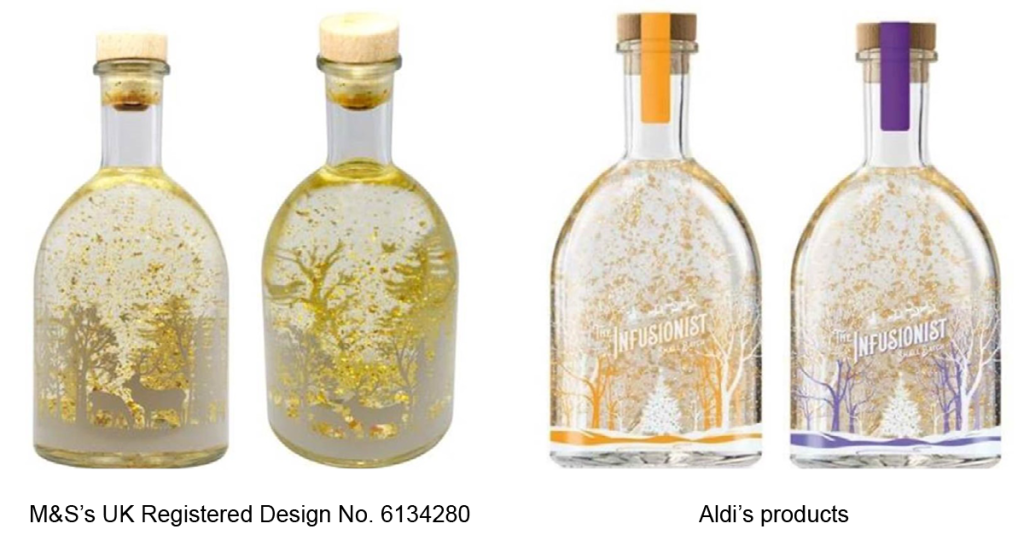
‘Look-alike’ products have fast become a fact of life across many industries but perhaps none more so than the food and drink sector. Makers of own-brand goods are often adept at sailing close to the wind – creating a product that, while reminiscent of the original, avoids infringing any intellectual property rights – such that it can be difficult for the original designer to protect their market share. However, in a recent decision from the UK’s Court of Appeal, ruling on a dispute between M&S and Aldi relating to their illuminated gin bottles, it was held that Aldi had crossed the line – demonstrating that registered designs can still be a highly effective tool in the battle against look-alikes. For those hoping to emulate M&S’s success, the case also highlights some important practice points which should be considered when deciding on a strategy for protecting a new design.
Registered designs are a type of intellectual property right available to protect the appearance of a product, as opposed to how it functions (for which a patent might be appropriate). In the case in question, M&S had obtained several UK-registered designs relating to their ‘light-up gin bottle’ product, one of which (UK 6134280) is shown below. Each registered design consisted of two photographs of their product, which was a gin-based liqueur containing edible gold flakes inside a decorated bottle with a light source at its base to illuminate the flakes when shaken up. Later in the same year, Aldi launched a rival product (also shown below), which also contained gold flakes suspended in a gin-based liqueur and a light at the base of a decorated bottle. In a recent decision,[a] the Court of Appeal upheld an earlier decision[b] from the Intellectual Property Enterprise Court, finding that Aldi’s product did provide the same ‘overall impression’ as that of M&S’s registered designs, each of which was therefore infringed.

[a] Marks and Spencer PLC v Aldi Stores Limited [2024] EWCA Civ 178
[b] Marks and Spencer PLC v Aldi Stores Limited [2023] EWHC 178 (IPEC)
To make its assessment, the Court needed to interpret the images contained in each registered design to ascertain what features the ‘informed user’ would see as making up its ‘overall impression’. It is here that the first factor contributing to the successful outcome for M&S becomes apparent: namely, their decision to illustrate the designs in the registrations using colour photographs rather than line drawings. In many scenarios, this would not be a desirable choice – since photographs typically show every detail of a product, their use can result in an unduly narrow scope of protection being afforded by the resulting design registration. As such, line drawings are often used in preference. However, in the present case, it is unlikely that line drawings would have adequately conveyed all the features of the design on which M&S relied. For example, in the judgement, Arnold LJ relied in part on a ‘golden shimmer’ visible on the neck of the bottle and on the gold flakes appearing ‘illuminated’ in the photographs to conclude that one of the features of the registered designs was an internal source of illumination. Had this not been the case, M&S’s case would have been significantly weakened, given that this was a key common feature between the registered designs and Aldi’s product.
M&S’s decision to use photographs in the design registrations – and hence to pursue a narrow scope of protection, targeting near-exactly the product they sold – was also likely the reason why Aldi did not dispute the validity of the design registrations. This effectively excluded what would usually be one of a defendant’s primary lines of argument and thus significantly strengthened M&S’s position.
Of course, the flip side of seeking highly specific protection in this way is exactly that: the protection afforded is narrow, and third parties may be able to work around it without too much difficulty. However, as this decision shows, that will not always be the case, and since it will often be the aim of the third party to produce something as close to the original product as possible, there can be a lot of value in securing design protection for exactly what is to be sold. Therefore, in deciding upon a suitable design filing strategy for any particular product, consideration should be given to obtaining a range of design registrations at different levels of generality, taking care not to overlook obtaining specific protection for the product to be marketed in the pursuit of greater breadth.
Another main topic of discussion in the decision is the scope of the grace period available under UK law. Whilst the detail will be of more interest to legal practitioners than to designers, it is nonetheless important for designers to be aware of the potential impact on their IP rights if they disclose their designs before applying for a design registration. UK law provides a one-year grace period, which means that a designer can disclose a design to the public, e.g. to test its market success, and then file an application to register the design. Provided the filing is made within one year of the first disclosure by the designer, those disclosures will not be considered when assessing the validity of the subsequent design registration.
The decision from the Court of Appeal does not change this basic premise. However, what it adds is that the grace period also affects the scope of a (valid) design registration. This is because the judgment over whether an allegedly infringing product produces the same ‘overall impression’ as the registered design (and thus infringes it) depends on the context of the field of designs known before the filing of the registered design. As stated in the leading UK decision[c] on the issue: ‘… if a new design is markedly different from anything that has gone before, it is likely to have a greater overall visual impact than if it is ‘surrounded by kindred prior art.’ … So protection for a striking novel product will be correspondingly greater than for a product which is incrementally different from the prior art, though different enough to have its own individual character and thus be validly registered.’
Significantly, in the new decision it was held that disclosures caught by the grace period provision are excluded from this assessment. However, Arnold LJ also decided that the grace period does not exclude all disclosures by the designer in the relevant 12 months, but only disclosures of the same design as the later design application or with the same ‘overall impression’. In practice, this means that if the designer publicly tests out a range of different but related designs during the 12-month period and then chooses to register one or more of them, the ultimate scope of protection for each of the design registrations could be narrowed because of the designer’s prior disclosure of the other designs, despite this having taken place during the grace period. In some cases, this could lead to a finding of non-infringement. However, in the matter at hand, the only disclosure of a distinct design made by M&S during the relevant 12 months was less similar to the registrations than some third-party disclosures already taken into account, and so this had minimal impact.
The degree to which the Court of Appeal’s ruling on this point of law may affect the outcome of an infringement matter will depend heavily on the circumstances of the case at hand (and may be small in many instances, as in the present dispute). Nonetheless, in situations where different but related designs exist – for instance, where a designer wishes to test out different variants or where there is a product range of different items with a relationship between the designs – it may be beneficial to avoid reliance on the grace period by filing the design application before making any public disclosures.
For further information on how to protect your products with designs, or if you have any questions in relation to this article, please find my contact details on my website profile or contact our dedicated designs team at gje@gje.com.
[c] Procter & Gamble Company v Reckitt Benckiser (UK) Ltd [2007] EWCA Civ 936


